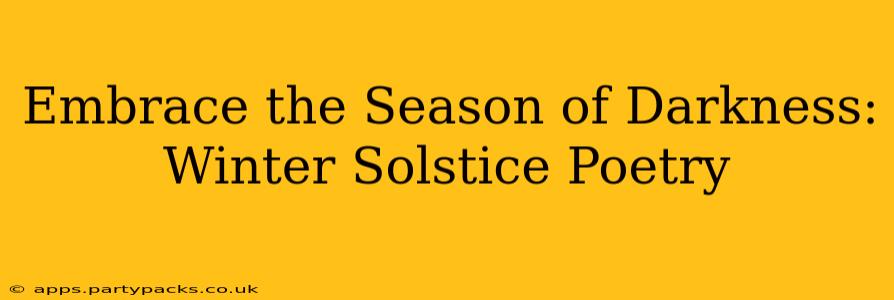The Winter Solstice, the shortest day and longest night of the year, holds a powerful symbolism across cultures and throughout history. It's a time of reflection, introspection, and a potent reminder of the cyclical nature of life, death, and rebirth. This season, often associated with darkness and dormancy, is also a time of profound beauty and potential, a period ripe for poetic expression. This article delves into the essence of Winter Solstice poetry, exploring its themes, styles, and the unique power it holds.
What is the significance of the Winter Solstice?
The Winter Solstice marks the astronomical beginning of winter in the Northern Hemisphere. It occurs when the Earth's tilt is furthest away from the sun, resulting in the shortest period of daylight. This astronomical event has been celebrated for millennia, with various cultures associating it with different symbolic meanings. For many, it represents a time of renewal, hope, and the promise of returning light. The darkest hour is often seen as a precursor to the gradual lengthening of days, a symbol of hope and resilience in the face of adversity.
What are the common themes in Winter Solstice poetry?
Winter Solstice poetry often explores themes of darkness, stillness, introspection, and the cyclical nature of life. Poets often use vivid imagery of winter landscapes – snow-covered fields, frozen rivers, bare trees – to reflect the inward journey of contemplation that this season inspires. Here are some prevalent themes:
- Darkness and Light: The contrast between the longest night and the promise of returning sunlight is a recurring motif, symbolizing the duality of life and the eventual triumph of light over darkness.
- Death and Rebirth: The symbolism of death and rebirth is central to many Winter Solstice poems, mirroring the natural world's cycle of dormancy and renewal.
- Introspection and Reflection: The stillness and quiet of winter provide a fertile ground for introspection, allowing poets to delve into their inner selves and explore themes of mortality, resilience, and hope.
- Hope and Renewal: Despite the darkness, the Winter Solstice also embodies hope, as it marks the turning point towards longer days and the eventual return of spring. This theme of renewal is often central to solstice celebrations and poetry.
How is the Winter Solstice celebrated poetically?
Celebrations often involve ritualistic practices, communal gatherings, and the creation of art, including poetry. Poems can be recited during solstice gatherings, creating a shared experience of reflection and celebration. The poetic expression of the solstice experience helps individuals connect with the deeper meaning of this turning point in the year.
What are some examples of Winter Solstice imagery in poetry?
Imagery is key to conveying the essence of the Winter Solstice. Poets often utilize evocative descriptions to capture the mood and atmosphere of this time of year. Common imagery includes:
- Snow: Softly falling snow, glistening snowdrifts, the stark beauty of a snow-covered landscape.
- Ice: Frozen rivers, glittering ice crystals, the cold, hard surface of ice.
- Darkness: The long, dark night, the absence of sunlight, the deep shadows of winter.
- Fire: The warmth and light of a fire, a symbol of hope and resilience in the face of darkness.
- Bare Trees: The stark beauty of leafless trees, their branches reaching towards the sky.
What are some famous Winter Solstice poems?
While there isn't a single canon of "Winter Solstice poems," many poems evoke the themes and imagery associated with the solstice. Searching for poems focused on winter, darkness, rebirth, or solstice celebrations will reveal many relevant works. You can find inspiration from poets who masterfully utilize nature imagery and explore themes of cyclical change.
How can I write a Winter Solstice poem?
Writing a Winter Solstice poem involves connecting with the season's essence through observation, reflection, and creative expression. Consider:
- Sensory details: Engage all five senses—sight, sound, smell, taste, and touch—to vividly portray the winter landscape and atmosphere.
- Symbolism: Use symbols to represent deeper meanings and themes, such as the darkness representing introspection, or the returning light symbolizing hope.
- Personal reflection: Draw on your own experiences and feelings related to the solstice to make your poem personal and meaningful.
- Form and style: Experiment with different poetic forms and styles to find the best way to express your vision.
The Winter Solstice, with its unique blend of darkness and promise, offers rich ground for poetic exploration. By embracing the season's symbolism and drawing on personal experiences, you can create powerful and moving poetry that captures the spirit of this special time of year.

